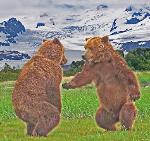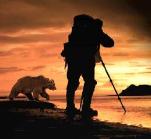
| Glaciers and Crevasses - What Are They? How Do They Form? |
pleasant. In fact, if you press the from
your hands melt the snow a bit, it
could hit hard enough to break
someone's nose.
Yet, to fully convert snow into ice, you
need a lot more pressure, as happens
in nature during an avalanche. Loose,
soft snow can race downhill at speeds
over 60 mph (100 kph), slamming into
trees and boulders, or simply into
other snow, with so much force that
chunks of snow are formed that they
are rammed ionto blocks so dense
and icy that they could be used for
building an ice palace. That's why
people trapped under the snow
surface during an avalanche often
cannot dig themselves out. It's like
being encased in concrete.
However, compacting snow and
turning it into ice doesn't necessarily
require a lot of heat or violence.
People walking on a snowy sidewalk,
or vehicles driving on a snowy road,
can compress snow into black ice.
Much the same thing happens in
nature If snow accumulates year after
year, getting deeper and deeper. The
weight of overlying snow can compact
that at the bottom. Supposedly, all it
takes is about 45 ft (15 m) of snow to
compress the bottom layer into ice.
When that mass of ice becomes deep
enough and heavy enough, it begins
to flow, forming a glacier. Large
glaciers move with so much force that
they can gouge chunks of bedrock out
of mountain slopes and grind them
into dust. Their force almost has to be
seen, to be believed.
Visiting Wolverine Creek and the
adjacent Chigmiut Mountains can
provide just that opportunity, whether
you see glaciers from the air, or by
walking on the ground nearby, if not
on the ice itself.
The following photos and text explain
more about how glaciers are formed,
how they transform landscapes, and
how that in turn drastically modifies the
ecology of vast areas of the world.
Some modifications affecting bears
and humans are the result of glacial
events which occurred millennia ago.
Others are consequences of glacial
processes still underway today.
Indeed, as glaciers shrink under the
onslaught of climatic warming, their
environmental impacts could be both
awesome and catastrophic. Which is
all the more reason to find glaciers
fascinating.
your hands melt the snow a bit, it
could hit hard enough to break
someone's nose.
Yet, to fully convert snow into ice, you
need a lot more pressure, as happens
in nature during an avalanche. Loose,
soft snow can race downhill at speeds
over 60 mph (100 kph), slamming into
trees and boulders, or simply into
other snow, with so much force that
chunks of snow are formed that they
are rammed ionto blocks so dense
and icy that they could be used for
building an ice palace. That's why
people trapped under the snow
surface during an avalanche often
cannot dig themselves out. It's like
being encased in concrete.
However, compacting snow and
turning it into ice doesn't necessarily
require a lot of heat or violence.
People walking on a snowy sidewalk,
or vehicles driving on a snowy road,
can compress snow into black ice.
Much the same thing happens in
nature If snow accumulates year after
year, getting deeper and deeper. The
weight of overlying snow can compact
that at the bottom. Supposedly, all it
takes is about 45 ft (15 m) of snow to
compress the bottom layer into ice.
When that mass of ice becomes deep
enough and heavy enough, it begins
to flow, forming a glacier. Large
glaciers move with so much force that
they can gouge chunks of bedrock out
of mountain slopes and grind them
into dust. Their force almost has to be
seen, to be believed.
Visiting Wolverine Creek and the
adjacent Chigmiut Mountains can
provide just that opportunity, whether
you see glaciers from the air, or by
walking on the ground nearby, if not
on the ice itself.
The following photos and text explain
more about how glaciers are formed,
how they transform landscapes, and
how that in turn drastically modifies the
ecology of vast areas of the world.
Some modifications affecting bears
and humans are the result of glacial
events which occurred millennia ago.
Others are consequences of glacial
processes still underway today.
Indeed, as glaciers shrink under the
onslaught of climatic warming, their
environmental impacts could be both
awesome and catastrophic. Which is
all the more reason to find glaciers
fascinating.







Understanding glaciers, along with their effects on landscapes and ecosystems, begins with learning how glaciers form. You already have important
clues if you've ever made a snowball, or if you've walked or driven over snow. Making a snowball transforms light, soft snow into something so hard that
clues if you've ever made a snowball, or if you've walked or driven over snow. Making a snowball transforms light, soft snow into something so hard that
Structure of a Glacier
sublimation (evaporation of solid ice) -- which are together known as ablation. At that point down the
length of a glacier where the amount of snow and ice being lost (i.e. ablated) each year exactly balances
the amount of new snow falling is called the snowline. The snowline at the end of each summer and fall is
called the annual snowline. The area above the annual snowline, where new accumulation exceeds
ablation, is known as the accumulation zone. The area below that snowline is the ablation zone. Any part of
the glacier where glacial ice is visible is within the current ablation zone. In June of each year, only the foot
of Double Glacier shows bare ice; but by September, ice is exposed along nearly the whole length of the
glacieries near Wolverine Creek -- mute testimony to the ravages of climatic warming. In the photo above,
the glacier ends in a lake. The white dots in the lake are floating icebergs calved off the glacier.
At the bottom of the snow, near where the solid glacial ice begins, is a layer of snow that is turning to ice.
Flakes have melted slightly, turning into crystals like wet rock salt. Although they stick together tightly
enough that shoveling through them is difficult, they have not yet congealed into a solid layer of ice. This
icy snow is called firn. Little firn exists below in the accumulation zone, because most of it has melted away.
So the equilibrium line between accumulation vs. ablation, and the snowline also approximate the lower limit
of firn.
sublimation (evaporation of solid ice) -- which are together known as ablation. At that point down the
length of a glacier where the amount of snow and ice being lost (i.e. ablated) each year exactly balances
the amount of new snow falling is called the snowline. The snowline at the end of each summer and fall is
called the annual snowline. The area above the annual snowline, where new accumulation exceeds
ablation, is known as the accumulation zone. The area below that snowline is the ablation zone. Any part of
the glacier where glacial ice is visible is within the current ablation zone. In June of each year, only the foot
of Double Glacier shows bare ice; but by September, ice is exposed along nearly the whole length of the
glacieries near Wolverine Creek -- mute testimony to the ravages of climatic warming. In the photo above,
the glacier ends in a lake. The white dots in the lake are floating icebergs calved off the glacier.
At the bottom of the snow, near where the solid glacial ice begins, is a layer of snow that is turning to ice.
Flakes have melted slightly, turning into crystals like wet rock salt. Although they stick together tightly
enough that shoveling through them is difficult, they have not yet congealed into a solid layer of ice. This
icy snow is called firn. Little firn exists below in the accumulation zone, because most of it has melted away.
So the equilibrium line between accumulation vs. ablation, and the snowline also approximate the lower limit
of firn.



Glaciers and The Landscapes The Create


around 100 ft (30 m) -- is relatively plastic, like hot tar, and can distort without cracking, whereas the shallower ice, like that on the surface of a lake,
cannot bend without cracking. Those cracks, called crevasses, are thus rarely more than 100 ft (30 m) deep. (The diagram below does not show the
water. The downhill movement of a glacier is facilitated by a thin layer of water between the ice and underlying bedrock. This water is melted off the
bottom of the glacier by pressure-generated heat; or it melted on the surface of the glacier, then sank to the bottom through crevasses, then even
deeper through channels melted by the sinking water.
cannot bend without cracking. Those cracks, called crevasses, are thus rarely more than 100 ft (30 m) deep. (The diagram below does not show the
water. The downhill movement of a glacier is facilitated by a thin layer of water between the ice and underlying bedrock. This water is melted off the
bottom of the glacier by pressure-generated heat; or it melted on the surface of the glacier, then sank to the bottom through crevasses, then even
deeper through channels melted by the sinking water.

Crevasses -- what are they, and how do they form?: The crystals in newly fallen snow -- as shown on the previous page and above left) are of ice
crystals are tightly frozen together in shallow ice. But the weight of shallow ice pressing down on deep ice, produces sufficient heat to slightly melt the
crystals are tightly frozen together in shallow ice. But the weight of shallow ice pressing down on deep ice, produces sufficient heat to slightly melt the



What is a Glacier? A glacier is a mass of ice that persists over many years, often millennia, and which moves under its own weight, flowing downhill
and spreading out from places where it is thickest towards the thinner margins.
and spreading out from places where it is thickest towards the thinner margins.

Lateral movement of a glacier as ice
(thinner ice).
(thinner ice).
| Longitudinal movement of a glacier down slope and from the head where depth and pressure are high, toward the thin, low-pressure foot. |

The diagram at upper left, with crevasses running side-to-side across a glacier
corresponds to the upper slope of the glacier shown in the photo at lower left, where the
ice had to bend downwards. By contrast, the crevasses run front to back near to foot of
the glacier where the ice movement had to shift to the left and right around the boulder at
the edge of the lake. Creveasses tend to be perpendicular to the direction of movement.
corresponds to the upper slope of the glacier shown in the photo at lower left, where the
ice had to bend downwards. By contrast, the crevasses run front to back near to foot of
the glacier where the ice movement had to shift to the left and right around the boulder at
the edge of the lake. Creveasses tend to be perpendicular to the direction of movement.
Site Visit Counter

off the roof of a house. In this
case, transition of snow into
plastic ice resulted from heat
rising from inside the attic.
Rather than breaking at the
rood edge, the ice bent over it
and curled under.
case, transition of snow into
plastic ice resulted from heat
rising from inside the attic.
Rather than breaking at the
rood edge, the ice bent over it
and curled under.



| Bear Viewing Association To watch, to wonder, and to conserve [email protected] Ph/Fax (907) 260-9059 (Office) 39200 Alma Ave. Soldotna, AK 99669 |


| Glaciers, Glacial Landscapes, and Their Roles in the Ecology of Alaskan Bears |